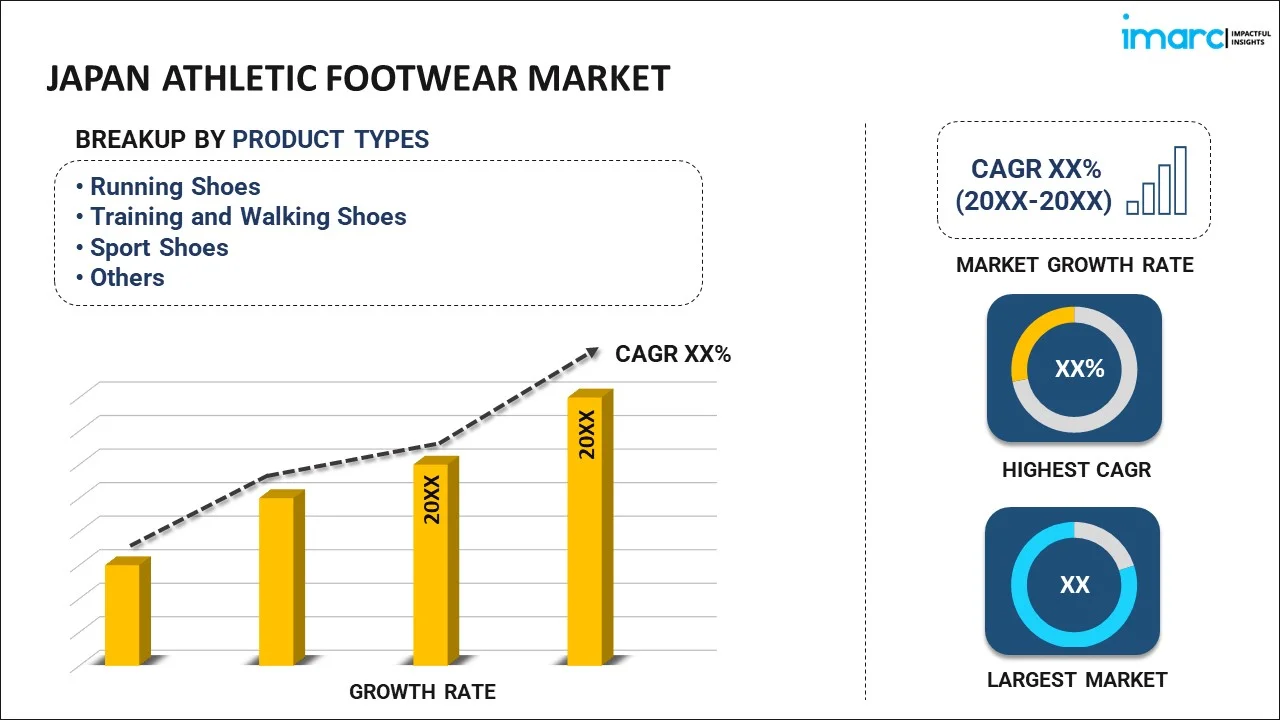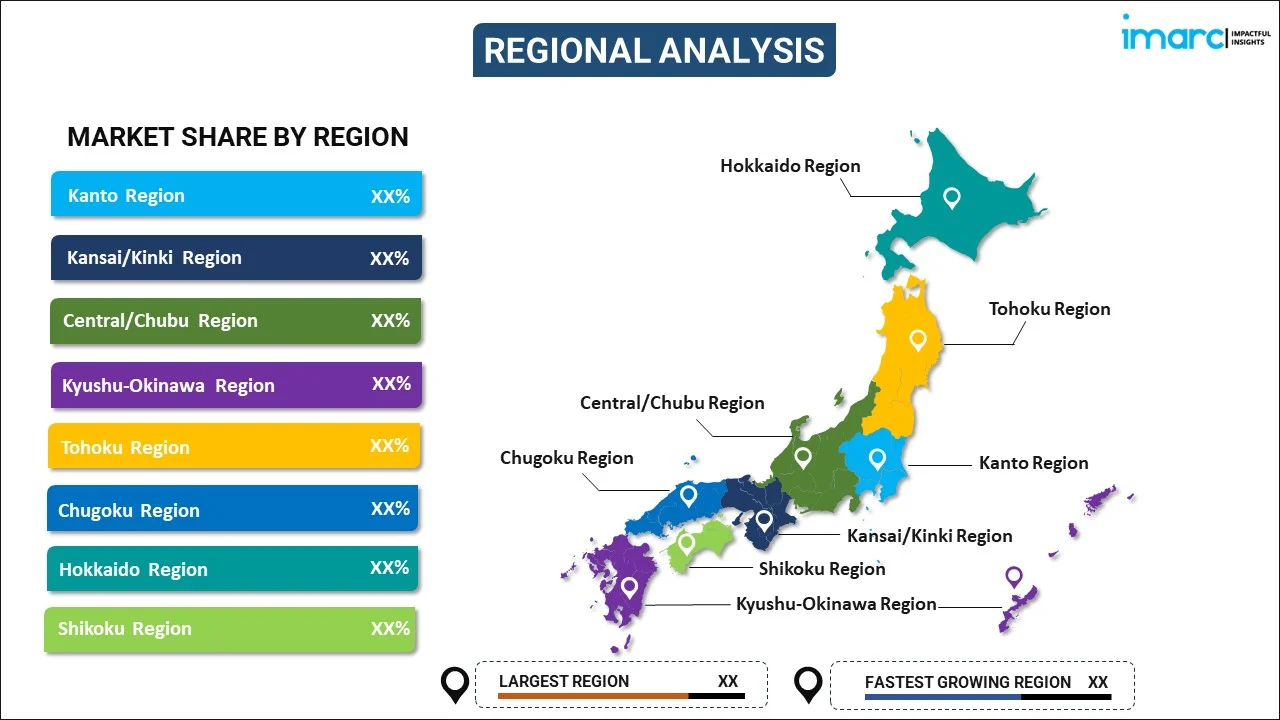
Japan Athletic Footwear Market Report by Product Type (Running Shoes, Training and Walking Shoes, Sport Shoes, Aerobic and Gym Wear Shoes, Trekking and Hiking Shoes, and Others), Sports Footwear Type (Tennis Shoes, Soccer Shoes, Basketball Shoes, Cricket Shoes), End User (Men, Women, Kids), Distribution Channel (Hypermarket and Supermarket, Specialty Store, Brand Outlets, and Others), and Region 2025-2033
Market Overview:
Japan athletic footwear market size reached USD 4.4 Billion in 2024. Looking forward, IMARC Group expects the market to reach USD 6.6 Billion by 2033, exhibiting a growth rate (CAGR) of 4.3% during 2025-2033. The market is being driven by significant factors, such as the surging support through endorsements and sponsorships from professional athletes and sports teams, a heightened awareness of the health and fitness advantages, and ongoing technological advancements.
|
Report Attribute
|
Key Statistics
|
|---|---|
|
Base Year
|
2024
|
|
Forecast Years
|
2025-2033
|
|
Historical Years
|
2019-2024
|
| Market Size in 2024 | USD 4.4 Billion |
| Market Forecast in 2033 | USD 6.6 Billion |
| Market Growth Rate 2025-2033 | 4.3% |
Athletic footwear, also known as sport shoes, are specialized footwear created for sports and physical exercises. They are meticulously designed to deliver comfort, support, and performance-enhancing attributes tailored to athletes and active individuals. Typically, athletic footwear incorporates features such as cushioning, stability, and traction to optimize performance while minimizing the risk of injury. These shoes are tailored for activities such as running, hiking, and sports like basketball, soccer, and tennis. They frequently utilize cutting-edge materials, technologies, and ergonomic designs to provide an excellent fit, shock absorption, breathability, and longevity. The significance of athletic footwear lies in its ability to enhance athletic performance, offer protection, and ensure the utmost comfort for the feet during demanding physical pursuits.
Japan Athletic Footwear Market Trends:
The athletic footwear market in Japan has evolved into a dynamic and competitive arena, reflecting the country's strong affinity for sports, fitness, and fashion. Several factors contribute to the market's robustness. Japan's cultural emphasis on physical activity, including sports such as baseball, soccer, and running, has fueled a consistent demand for high-quality athletic footwear. Moreover, the influence of fashion and lifestyle trends plays a significant role in shaping consumer preferences, with many individuals choosing athletic footwear not just for sports but also as a style statement. Endorsements and sponsorships by professional athletes and sports teams carry substantial weight in Japan, driving brand loyalty and consumer trust. These collaborations often lead to the creation of exclusive and sought-after athletic footwear lines, further boosting market growth. Besides this, people are now more inclined to invest in shoes that offer not only performance-enhancing features but also support overall foot health during various physical activities. Advancements in technology have not gone unnoticed in the Japanese athletic footwear market. Innovative materials, cushioning technologies, and ergonomic designs are continuously introduced to enhance performance and comfort. In summary, cultural proclivities, fashion influence, sports endorsements, health consciousness, and technological innovations are anticipated to fuel the regional market in the coming years.
Japan Athletic Footwear Market Segmentation:
IMARC Group provides an analysis of the key trends in each segment of the market, along with forecasts at the country level for 2025-2033. Our report has categorized the market based on product type, sports footwear type, end user, and distribution channel.
Product Type Insights:

- Running Shoes
- Training and Walking Shoes
- Sport Shoes
- Aerobic and Gym Wear Shoes
- Trekking and Hiking Shoes
- Others
The report has provided a detailed breakup and analysis of the market based on the product type. This includes running shoes, training and walking shoes, sport shoes, aerobic and gym wear shoes, trekking and hiking shoes, and others.
Sports Footwear Type Insights:
- Tennis Shoes
- Soccer Shoes
- Basketball Shoes
- Cricket Shoes
A detailed breakup and analysis of the market based on the sports footwear type have also been provided in the report. This includes tennis shoes, soccer shoes, basketball shoes, and cricket shoes.
End User Insights:
- Men
- Women
- Kids
The report has provided a detailed breakup and analysis of the market based on the end user. This includes men, women, and kids.
Distribution Channel Insights:
- Hypermarket and Supermarket
- Specialty Store
- Brand Outlets
- Others
A detailed breakup and analysis of the market based on the distribution channel have also been provided in the report. This includes hypermarket and supermarket, specialty store, brand outlets, and others.
Regional Insights:

- Kanto Region
- Kansai/Kinki Region
- Central/ Chubu Region
- Kyushu-Okinawa Region
- Tohoku Region
- Chugoku Region
- Hokkaido Region
- Shikoku Region
The report has also provided a comprehensive analysis of all the major regional markets, which include Kanto Region, Kansai/Kinki Region, Central/ Chubu Region, Kyushu-Okinawa Region, Tohoku Region, Chugoku Region, Hokkaido Region, and Shikoku Region.
Competitive Landscape:
The market research report has also provided a comprehensive analysis of the competitive landscape. Competitive analysis such as market structure, key player positioning, top winning strategies, competitive dashboard, and company evaluation quadrant has been covered in the report. Also, detailed profiles of all major companies have been provided.
Japan Athletic Footwear Market Report Coverage:
| Report Features | Details |
|---|---|
| Base Year of the Analysis | 2024 |
| Historical Period | 2019-2024 |
| Forecast Period | 2025-2033 |
| Units | Billion USD |
| Scope of the Report | Exploration of Historical and Forecast Trends, Industry Catalysts and Challenges, Segment-Wise Historical and Predictive Market Assessment:
|
| Product Types Covered | Running Shoes, Training and Walking Shoes, Sport Shoes, Aerobic and Gym Wear Shoes, Trekking and Hiking Shoes, Others |
| Sports Footwear Types Covered | Tennis Shoes, Soccer Shoes, Basketball Shoes, Cricket Shoes |
| End Users Covered | Men, Women, Kids |
| Distribution Channels Covered | Hypermarket and Supermarket, Specialty Store, Brand Outlets, Others |
| Regions Covered | Kanto Region, Kansai/Kinki Region, Central/ Chubu Region, Kyushu-Okinawa Region, Tohoku Region, Chugoku Region, Hokkaido Region, Shikoku Region |
| Customization Scope | 10% Free Customization |
| Post-Sale Analyst Support | 10-12 Weeks |
| Delivery Format | PDF and Excel through Email (We can also provide the editable version of the report in PPT/Word format on special request) |
Key Questions Answered in This Report:
- How has the Japan athletic footwear market performed so far and how will it perform in the coming years?
- What has been the impact of COVID-19 on the Japan athletic footwear market?
- What is the breakup of the Japan athletic footwear market on the basis of product type?
- What is the breakup of the Japan athletic footwear market on the basis of sports footwear type?
- What is the breakup of the Japan athletic footwear market on the basis of end user?
- What is the breakup of the Japan athletic footwear market on the basis of distribution channel?
- What are the various stages in the value chain of the Japan athletic footwear market?
- What are the key driving factors and challenges in the Japan athletic footwear?
- What is the structure of the Japan athletic footwear market and who are the key players?
- What is the degree of competition in the Japan athletic footwear market?
Key Benefits for Stakeholders:
- IMARC’s industry report offers a comprehensive quantitative analysis of various market segments, historical and current market trends, market forecasts, and dynamics of the Japan athletic footwear market from 2019-2033.
- The research report provides the latest information on the market drivers, challenges, and opportunities in the Japan athletic footwear market.
- Porter's five forces analysis assist stakeholders in assessing the impact of new entrants, competitive rivalry, supplier power, buyer power, and the threat of substitution. It helps stakeholders to analyze the level of competition within the Japan athletic footwear industry and its attractiveness.
- Competitive landscape allows stakeholders to understand their competitive environment and provides an insight into the current positions of key players in the market.
Need more help?
- Speak to our experienced analysts for insights on the current market scenarios.
- Include additional segments and countries to customize the report as per your requirement.
- Gain an unparalleled competitive advantage in your domain by understanding how to utilize the report and positively impacting your operations and revenue.
- For further assistance, please connect with our analysts.
 Inquire Before Buying
Inquire Before Buying
 Speak to an Analyst
Speak to an Analyst
 Request Brochure
Request Brochure
 Request Customization
Request Customization




.webp)




.webp)












